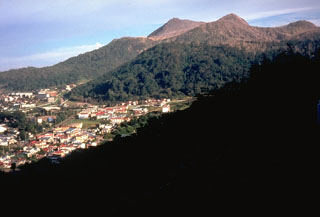Report on Toya (Japan) — January 1981
Scientific Event Alert Network Bulletin, vol. 6, no. 1 (January 1981)
Managing Editor: Lindsay McClelland.
Toya (Japan) 1980 cryptodome uplift and seismicity summarized
Please cite this report as:
Global Volcanism Program, 1981. Report on Toya (Japan) (McClelland, L., ed.). Scientific Event Alert Network Bulletin, 6:1. Smithsonian Institution. https://doi.org/10.5479/si.GVP.SEAN198101-285030
Toya
Japan
42.544°N, 140.839°E; summit elev. 733 m
All times are local (unless otherwise noted)
Cryptodome uplift and local seismicity continued through 1980. Local seismicity continued an irregular decline through 1980 (figure 19 and table 4). Felt shocks averaged 3/day in 1980, but swarms of 30-40 felt events in a single day occurred about once a month. . . . Careful correlation of seismic records with observed surface deformation and faulting revealed that larger earthquakes occurred simultaneously with measureable fault movements.
Table 4. Monthly number of local seismic events at Usu, 1980-81. Courtesy of JMA.
| Month | Recorded Events | Felt Events |
| Jan 1980 | [1177] | 234 |
| Feb 1980 | 1004 | 216 |
| Mar 1980 | 890 | 162 |
| Apr 1980 | 582 | 92 |
| May 1980 | [674] | 121 |
| Jun 1980 | [221] | 32 |
| Jul 1980 | 601 | 112 |
| Aug 1980 | 486 | 82 |
| Sep 1980 | 620 | 108 |
| Oct 1980 | 413 | 69 |
| Nov 1980 | 604 | 106 |
| Dec 1980 | [571] | 94 |
| Jan 1981 | 357 | 63 |
| Feb 1981 | 289 | 49 |
| Mar 1981 | 235 | 41 |
| Apr 1981 | 485 | 92 |
| May 1981 | 153 | 35 |
| Jun 1981 | 151 | 33 |
| Jul 1981 | 423 | 89 |
| Aug 1981 | 317 | 64 |
| Sep 1981 | 244 | 41 |
| Oct 1981 | 315 | 52 |
| Nov 1981 | [290] | 54 |
| Dec 1981 | 440 | 105 |
The rate of cryptodome uplift decreased through 1980, from 5 cm/day in January to 3-4 cm/day in December [at the peak of] Usu-Shinzan . Northward lateral movement of the N flank continued at a similar rate. As a result, compression of the ground N of the volcano also continued, affecting several towns and villages.
Geological Summary. Usuzan, one of Hokkaido's most well-known volcanoes, is a small stratovolcano located astride the southern topographic rim of the 110,000-year-old Toya caldera. The center of the 10-km-wide, lake-filled caldera contains Nakajima, a group of forested Pleistocene andesitic lava domes. The summit of the basaltic-to-andesitic edifice of Usu is cut by a somma formed about 20-30,000 years ago when collapse of the volcano produced a debris avalanche that reached the sea. Dacitic domes erupted along two NW-SE-trending lines fill and flank the summit caldera. Three of these domes, O-Usu, Ko-Usu and Showashinzan, along with seven crypto-domes, were erupted during historical time. The 1663 eruption of Usu was one of the largest in Hokkaido during historical time. The war-time growth of Showashinzan from 1943-45 was painstakingly documented by the local postmaster, who created the first detailed record of growth of a lava dome.
Information Contacts: JMA, Tokyo; I. Yokoyama, Hokkaido Univ.


